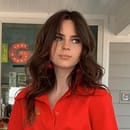On Sept. 8, 2022, Buckingham Palace announced the death of Queen Elizabeth II.
I learned about her death over a facetime call with my mom. We’d been chatting on the phone for well over 30 minutes, and after running out of things to say, she put me on pause and started to scroll through Twitter.
“Breaking News: Buckingham Palace has Announced the Death of Queen Elizabeth II” was the first Tweet she saw and what she read aloud to me.
As she read this, the image that popped into my head was my favorite of Queen Elizabeth II— The picture is of her standing on the Buckingham Palace balcony, smiling down at the crowd that gathered for her Platinum Jubilee’s Trooping of the Colour Parade. When I first saw the photo, it immediately became my favorite because, not long earlier, I learned about the significance of the outfit she chose to wear the day the photo was captured.
The week after she passed, media coverage of the Queen remained at a constant, and since I live on Vogue.com and Elle.com, a lot of the coverage I read was about her royal fashion— an aspect of her life I think has an interesting (and quite fun) story to tell, so here it is:
On June 2, 1953, her majesty took the throne and assumed two royal titles: The Queen of State and the Queen of Style, titles she held for over 70 years.
During her time as Head Monarch, the Queen managed to make the phrase “dress for the part” her own, never taking a day off from serving her beloved people with some of the greatest fashion moments in history. Frequently dressed in bedazzled crowns, patterned dresses, and bold-colored coats, the Queen’s multi-million dollar wardrobe was one that represented the nations under her reign fabulously.
Diplomatic Dress
If anyone proved that fashion could make a political statement, it was Queen Elizabeth II. Even in the earliest years of her reign, the Queen’s wardrobe spoke volumes in signifying her participation in diplomatic duties. One of the earliest moments was her first visit to the Federal Republic of Germany, which was the first official visit by a British royal since World War II. To celebrate the reconciliation between the two countries, the Queen wore a sunshine-colored coat and a yellow frilled hat. Not only did her color choice reflect the joyous moment, but it also made her unmissable while standing along the sea of hundreds of British troops dripped out in military green.
But Queen Elizabeth II’s fashion sense wasn’t built solely around matters of business, the Queen often loved to play— with pops of color, that is. Take her outfit from the 1999 Royal Variety performance for example, the Queen was seen wearing a neon sequined top, a flowy gold skirt, and diamonds on every appendage. This look was snazzy, much like the event.
As eccentric as any event the Queen attended might have been, Her Majesty’s outfits always remained representational of her royal position. In lieu of succumbing to a constrictive wardrobe, decades’ worth of outfits styled to perfection were made especially for Queen Elizabeth II, outfits that ensured the monarch looked powerful and timeless but not rigid.
Tall Standing Tifters
Take her hats, for example, a staple in the Queen’s closet. Though discreet, these hats communicated quite a strong message. They doubled as both an added accessory—often acting as a pop of color or frill for her outfit—and also gave the illusion that the Queen was taller than she truly was, which subtly contributed to her royal estimation. Since the Queen stood at only 162 centimeters, it was easy for the Queen to be hidden when she was always meant to stand out, which is why she opted for the tall standing tifters.
Hartnell’s Designs
Throughout her reign, the Queen clearly understood the weight of her role; her clothes proved a case in point. Working mainly with British fashion designer Norman Hartnell, the Queen always had a stylist who perfectly emulated her status through stylish symbols. His ability to do so was adored by the Queen, so much so that he was the designer of her wedding gown— a pale gold structured dress embroidered with crystals.
Like her wedding gown, the Queen wore one of Hartnell’s designs for her coronation at Westminster Abbey in 1953. The dress was a short-sleeved gown decorated with gold and silver floral emblems that denoted the United Kingdom and Commonwealth nations that transitioned under her reign.
Platinum Jubilee
Keeping true to the yellow motif found in her wardrobe, the queen’s most exuberant outfit during her Platinum Jubilee celebration was her blue and yellow frock worn during tea time with Paddington Bear— a look paired with a necklace made of rows of pearls, earrings to match and of course, one of her heirloom brooches to tie her festive look together.
For the 2022 Trooping the Colour parade, a celebration that marks the official birthday of the British Sovereign for over 260 years, the Queen wore an outfit known and loved by the royal family. Queen Elizabeth II stepped out and joined the festivities in her classic pale-blue wool dress and pearl-trimmed matching jacket her grandmother Queen Mary was especially fond of. Elements were added to the outfit to add a celebratory hue to her look. Paired with the dress was a set of pearl earrings and a necklace, white gloves, a wide-brimmed hat (of course), and one of her recognizable brooches. (This was the look the Queen was wearing when my favorite photo of her was captured.)
The Queen’s fashion sense kept the world in awe for over 70 years. From the time she was coronated to every day after, Her Majesty proved herself worthy of being regarded as the style icon the world will forever remember her as.


